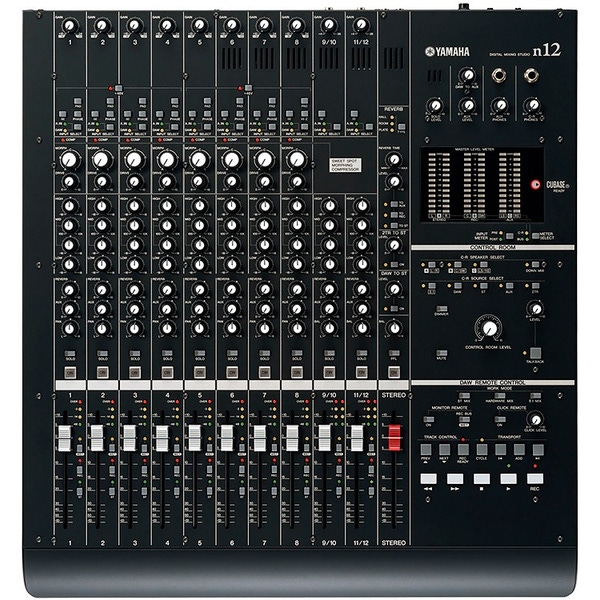The Yamaha N12 isn’t new to review, but it’s a cool piece of kit that performed well in its prime and still holds up today. The digital mixer and audio interface provided seamless Cubase integration and hands-on control for an intuitive workflow.
The Yamaha N12 Is a Powerful Mixer Built to Excel with Cubase
The Yamaha N12 is a 12-channel/two-bus digital mixer with eight mic preamps, per-channel three-band EQ, compression, a proprietary Yamaha reverb algorithm, and direct Cubase integration. At the time, the N12 was the peak of an “analog-style” digital recording/mixing setup. If we’re to date it a bit, the N12 originally shipped with Cubase AI 4 (a “lite” version), which is now in version 12!
Still, the secondhand N12 market is alive and thriving. It performs perfectly well as a standalone device, so it’s suitable for small-scale live sound reinforcement, live streaming, or just as a simple home studio mixer.
What Makes It Compatible with Cubase?
Yamaha’s partnership with Steinberg actually predated the former company’s acquisition of the latter in 2004. It’s only natural that the N-series digital mixers, appearing a few years later, would include Cubase integration. Without Cubase, the N12 still integrates with any other DAW as an audio interface/controller, albeit with less grace and potential for a few more headaches.
Yamaha N12 Review Rundown
Interface & Ease Of Use
Anyone familiar with recording consoles and mixers can attest to the intuitiveness of a product like the Yamaha N12. Giving it a brief once-over, you can quickly and easily get the lay of the land. Sooner than later, you’re having hands-on control over a live performance or the front-end of a recording system.
The N12 is pretty standard as far as mixers go, at least in terms of interface and ease of use.
Yamaha N12 Sound Quality
The N12 records at qualities up to 24-bit/96 kHz. That’s as good as any current digital system. As far as the preamps go, they’re surprisingly clean and clear, with next to no noise whatsoever, even at higher gain settings. On channels one through eight you have what Yamaha calls a morphing compressor — a fool-proof design to make compression usable for beginners — and the three-band EQ is entirely serviceable without coloring the sound more than one should desire.
- RELATED: Best Home Studio Monitors for 2023
- RELATED: Summing Mixer | Digital or Analog?
All in all, and considering we’re talking about a roughly 15-year-old digital mixer, the N12 was (still is?) an impressive piece of gear.
Channels
The N12 includes eight mono channels and two stereo channels for a total of 12. Eight channels and preamps are enough to record a drum kit, so it’s easily suited to full-band recordings and smaller scale live productions. In the immortal words of Yngwie Malmsteen, whom I’ve quoted numerous times, “more is [obviously] more,” but 12 is enough for this level of mixer.
Who Is the Yamaha N12 Digital Mixer Built For?
The Yamaha N12 was the perfect companion to Cubase users at the time. The seamless integration, for tactile control over digital software, was a huge plus. Anyone accustomed to working on consoles could get the same feel in their home studio with the quality and convenience of digital audio.
Today, it might be a little tricky to sell a FireWire interface/mixer, but it’s still an awesome piece of equipment. If you’re reading this and there’s still any appeal, then you’re exactly who should own an N12 in 2023! At the end of the day, this is audio — we love old things that did a great job then and continue to do a great job now.
Closing Thoughts: The Yamaha N12 Mixer Is a Great Choice No Matter Which DAW You Use
The Yamaha N12 catered to Cubase users, but it could still interface with any DAW. Multiplying its usefulness as a standalone mixer, the N12 was and remains a nifty board for live sound and recording. If you’re interest is piqued, definitely check the secondhand market to get your hands on one of these classic late-aughts mixers.
